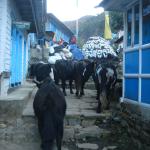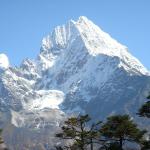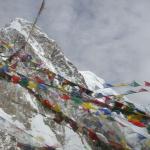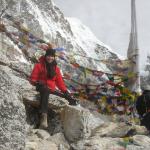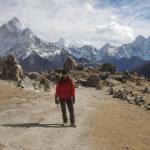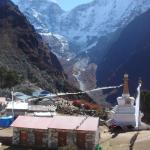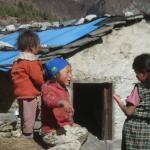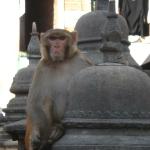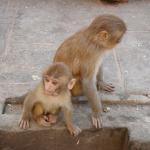© 2011 Sabrina Swenson. All Rights Reserved.
Nepal
November, 2009
It was one of the hardest things I have ever done; a 13 day trek to Mt. Everest base camp.
I flew into Kathmandu and spent a few days wandering around this crazy and lively city. After, a driver and my guide picked me up and we drove to the airport to fly to the tiny airstrip at Lukla. This airport is something to marvel as it has a single airstrip right on the side of a mountain. Watching planes take off and land is a joy. It no doubt takes some well trained pilots to land here. You land going uphill and if you do not stop in time you run into the side of the mountain. You definitely known when you've made contact with the ground when you land as the plane is firmly planted on the runway. There are also several helicopter companies operating out of Lukla making it an all around enjoyable airport to watch. After having a bite to eat at the airport we were off on our trek. It was just my guide and me; Dil, a young but strong Nepalese man who after his father's untimely death years earlier had been the "man of the house" ever since, even though he was now just barely 20. I carried a small day backpack and Dil carried the remainder of my items. This mostly consisted of thermal clothing, a down sleeping bag and toiletries. The path varied greatly during the trek, anything from stone steps to sand, to dirt and higher up were massive boulders you had to navigate. There was also snow and ice around base camp. I realized quickly this was not a trip for the weak or unfit! On the second day (a rather punishing day) as I felt that my lungs and/or heart may implode at any moment a million questions raced through my mind.... Didn't I have a heart murmur? Maybe I should have consulted a Dr. before undertaking this trek? Did my young guide realize that I was like, 20 years older than him? I'm not exactly a spring chicken anymore you know?? Why was he walking so fast?? In the end, I resolved to just suck it up and continue putting one foot in front of the other (the only thing you can do).
On a few of the tougher days I'm sure I annoyed Dil (and sounded like a little kid) when I kept asking "how much further"? Much to my dismay and irritation the answer would always be a generic, non-committal "not far". As a very specific and detail oriented person this sort of answer maddens me. I would have much preferred "well Miss Sabrina, we are approximately 1.8 clicks South by South East of our destination and at the current rate of ascent, given any unforeseen circumstances, I estimate our time of arrival to be in approximately 16.7 minutes". This sort of answer I understand, "not far" simply does not compute for me. Unfortunately, I have found in the much less time obsessed culture of third world countries around the world, "not far" is as good as you're going to get!
By the fourth day I had completely lost my appetite and would not be hungry again until around day 11. You would think with all the calories I was burning I would be ravenous but I simply was not interested in eating what-so-ever. (It may have been from the altitude or the Diamox I was taking for altitude sickness) I was, however, thirsty!! Anything I could get my hands on I drank, copious amounts of water, Coke and tea. My guide tried endless to get me to eat and I would usually choke down a piece of toast to make him happy or 1/2 a bowl of soup.
The altitude does other funny things to you. Aside from not being hungry I also felt pressure in my head. Not a headache per se just an unusual (this can't be good for me) pressure. The altitude also made my travel alarm stop and caused my camera to act funny. If it does this to electronics, imagine what it's doing to the human body!
The only day I felt really ill was on day 6 when we had an acclimatization day at Dingboche. We were staying in the same tea house that night and were supposed to do a simple 4 hour trek up to Chhukhung and back. I made it 1 1/2 hours and was walking sideways and stumbling when my guide said I was not well and that we should go back. We returned to the tea house and I spent the entire day in all my thermal and goose down clothes sitting in the sun trying to get warm. No matter how much I bundled up I was still freezing. I realized it was just me as I looked around and noticed everyone else was just in a fleece. My guide said I may have to go down the following day to a lower altitude but luckily the next morning after a good sleep I felt much better and we continued up.
Every day we would see red rescue helicopters flying around plucking up people who had fallen ill. I hoped I wouldn't be one of them! One day I actually saw a foreigner completely passed out on the back of his Nepalese guide. The man was complete dead weight. The Nepalese man was taking him to a rescue helicopter pick up point. He had the man on his back like he was giving him a piggy back ride and had fastened a cord around the man and tied him to his back. I looked at my guide Dil (who stood almost a foot shorter than me) and realized passing out was simply not an option for me for if I were to be strapped to Dil's back surely my feet and quite possibly my knuckles would be dragging on the ground! I vowed to keep going know matter what.
Along the route the accommodations you stay at are called tea houses. Yes, this sounds all cute and sweet however imagine a run down Swiss chalet sans heating or insulation. The only warmth provided was from a yak dung burning stove in the middle of the common area. Yes, I said yak dung. This precious "fuel" is dried and when thoroughly dry put into the wood burning stove just like wood except for the fact that this stuff came out of a yak! It is actually easy to burn if dried properly and is used all over Nepal. It does create some smoke and smarts the eyes for a bit but after a while you get used to it. The smell, however, does linger as I found out when I was out in the pristine Everest air the next day when I smelt my coat.... the yak dung doesn't leave. Since everyone smells the same however, no one really cares. Once you are ready to retire for the evening at the tea house you have to leave the yak dung fire in the common area (that is IF they have it lit) and retire to your freezing cold room. This is where the down sleeping bag comes into play and if you're lucky they provide a blanket as well. Each room I stayed at had a pillow but only some had blankets. Some of the rooms at lower altitude had lights and electricity but the higher you went most didn't have electricity in the room and so you needed a headlamp. Also, at lower altitude there would be one sink by the toilets to brush your teeth but again, further up there was no sink and you had to haul yourself outside into the Arctic tundra in the pitch black of night to brush your teeth outside with a bottle of water. As far as taking a shower...... what shower?? Besides, it was so cold the last thing you wanted to do was strip down! There were no showers except in Namche Bazar which you hit on day 2 of the trek. And so, wet wipes were the way to go. It was so cold the higher we went I took to sleeping and wearing during the day the same clothes without ever taking them off. A hat and 2 hoods, 5 tops/coats, 2 pants, 3 pair or socks, a scarf and gloves. I slept and walked all day in these clothes for three days! Why endure the dreaded tea house you ask? The only other alternative was to camp! Can you imagine being outside in that cold in a tent!? This was definitely not a trip for the high-maintenance crowd!
We would trek on average between 3 and 8 hours a day. My guide liked to start early and that was fine with me. Breakfast would be at 0630 and we would be out the door by 0700. We would trek, stopping occasionally to rest and for lunch and then would arrive at the next tea house usually by early afternoon. After dropping my stuff in my room I would usually sit in the common area and have a tea to warm up. As I watched each bedraggled trekker stagger into the tea house each looking wild eyed and bewildered I would think to myself; I feel your pain brother... I feel your pain! I found most of the trekkers were between their mid 20's to mid 40's. There seemed to be a large amount of Germans and French (they could have been Swiss). Occasionally, however, I would see a group of elderly Japanese movin on out!
When you are trekking you often have to move over to the side to let a heard of yaks pass with their heaving goods strapped to their backs. These beasts seem to be made for walking on this rocky terrain. There were usually about 5 of them in a row with one or two Nepalese guiding them. I was told they put the young yaks in the back to persuade the older ones up front to get going. They wore cow bells around their necks, luckily, so you could hear them coming. They had huge winding horns and looked a bit intimidating from their sheer girth alone but were actually quite docile as long as you didn't get in their way.
You would also quite often see Nepalese men, woman and children carrying abnormally large loads of goods on their back. They had a weight and balance system going where they would have a strap around the bottom of their goods and then while the goods were on their back they would put the other end of the strap around their forehead carefully balancing the load. My guide said they sometimes carry to to 100 kilos (220 pounds) that way. Considering these are very small people that is well more than they weigh. You could tell they were used to the altitude and would zip along up the mountain in their plastic shoes without any socks carrying more than they weighed while we foreigners would be huffing and puffing carrying a 5 pound backpack with our high tech gore-tex boots.
By day 8 we made it to Everest base camp at 17, 700 feet. The following day we went even higher to Kala Patthar at 18,208 feet for a sweeping view of the Himalayan mountain range. This was especially tough as the "trail" was straight up and near the top was just a sea of large boulders you had to crawl over. I was 3/4 of the way up when all of a sudden I tried to take a huge breath of air but nothing would go in. I bent over and tried again but nothing was going in or out. I dropped my walking sticks and fell to my knees and my throat starting making gasping/gurgling noises I have never heard come from me before. I looked up at my guide like "what the..." and he said I needed some hot water. Luckily he had brought some although by then it was just luke warm and I took a big swig. The gurgling/gasping immediately stopped and I could breath again. He said it was because the air was so cold and so thin. It was a terrifying moment that I hope to never experience again! We continued and I made it to the top of Kala Patthar. I was all smiles as I took that last step to the top, I collapsed onto a boulder watching others with the same look on their face reach the top. The view was stunning from this view point. We were surrounded 360 degrees by the Himalayan mountain range.
After lingering on the top of Kala Patthar, breathing in the freshest air I have ever experienced, we eventually started our long trek back to Lukla. With each passing day I felt better and better and by day 11 I was starving. I made up for all the days I was not hungry by eating more than my share. I felt great! It was also nice to be trekking mostly down hill. I didn't realize how far we had come until we were retracing our steps most of the way down. Had I known in advance all that was in store for me on this trip I don't think I would have signed up! Having done it now though, I am so glad that I did! If you were to ask if I wanted to do it again, however, the answer would definitely be "not again in this lifetime!".
An interesting tidbit about Everest (and something I always wondered) is that it always appears black on top whilst all the surrounding mountains have snow on them. It's because of the winds. Everest is so high up that the wind blows the snow off the peak. Also, there is a perpetual cloud over Everest right at the top that makes it look like a smoking volcano. Again, it's because it's so high up it's in the jet stream. The peak is at 29,029 feet. After my reaching just over 18,000 feet the thought of going another 11,000 feet to the summit just seems totally impossible to me. I've always had a great respect for those that have attempted to summit this beast of a mountain and especially to those (unbelievably) who do make it. Having just trekked to the relatively low height (by comparison) of base camp, my respect for those who try to summit has grown exponentially. It obviously takes a very special kind of person to possess that type of tenacity, strength and endurance.
After making it back down to Lukla and another hearty meal I flew back to Kathmandu where the weather was warm. I relaxed and reveled in the heat as I thawed my tired, worn-out, haggard body... I felt like I'd been in a train wreck! This was one tough but rewarding trip. I'm so glad I did it!
Click here to add text.









